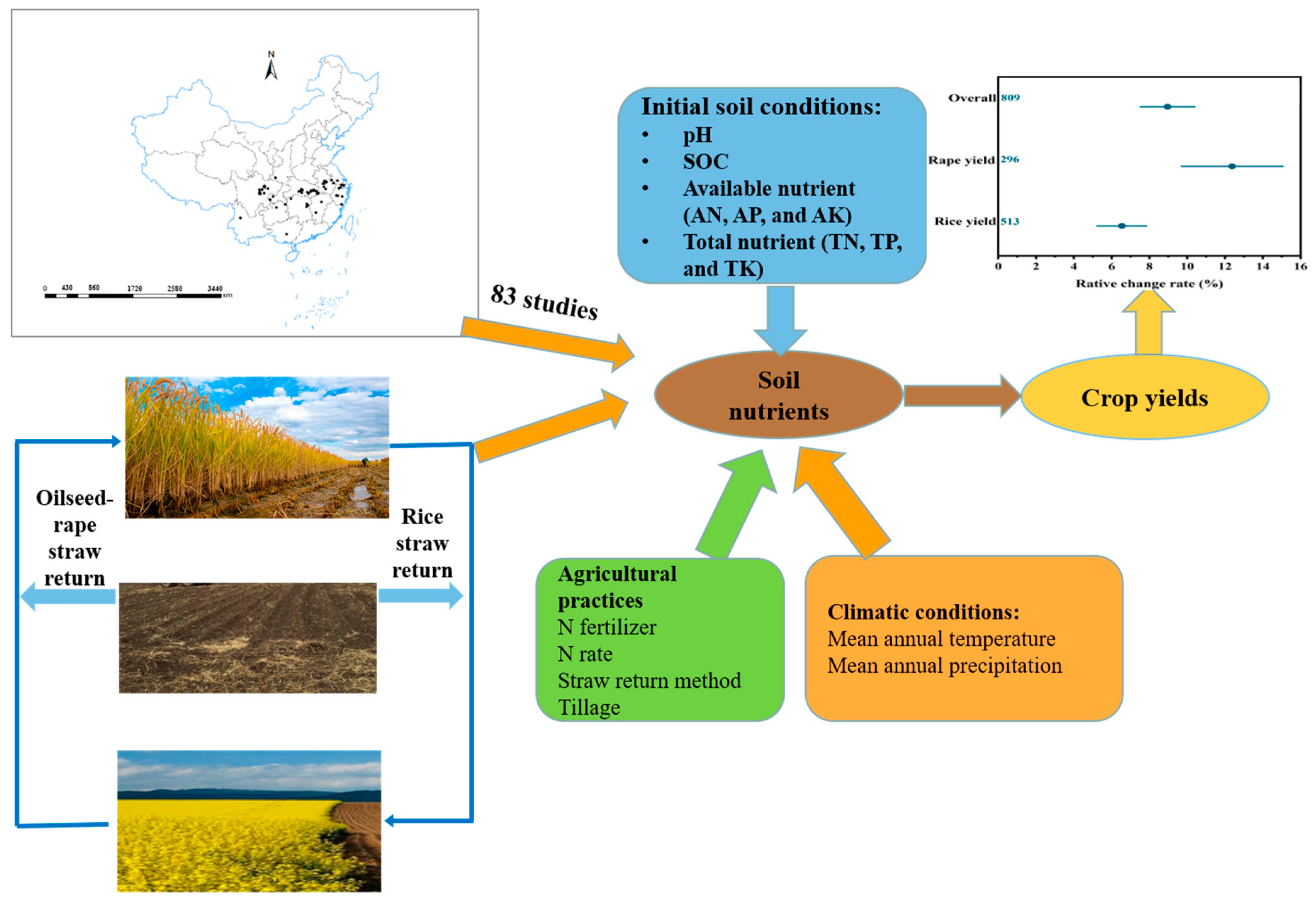Agriculture | Free Full-Text | Optimal Soil, Climate, and Management Factors for Maximizing Crop Yield and Soil Nutrients in a Rice–Oilseed Rotation System with Straw Return
[ad_1]
Figure 1.
Conceptual figure depicting the relative changes in crop yields in oilseed–rice cropping systems under straw return and geographical distribution of the field experiment sites across China; includes the meta-analysis. Note: SOC, soil organic carbon; AN, soil available nitrogen, AP, soil available phosphorus, AK, soil available potassium, TN, soil total nitrogen, TP, soil total phosphorus, TK, soil total potassium. The numbers in the left of the pictures represent the sample size. The mean effect and 95% confidence interval (CI) are shown if the CI does not overlap with the 0 line, which means significant effects (p < 0.05).
Figure 1.
Conceptual figure depicting the relative changes in crop yields in oilseed–rice cropping systems under straw return and geographical distribution of the field experiment sites across China; includes the meta-analysis. Note: SOC, soil organic carbon; AN, soil available nitrogen, AP, soil available phosphorus, AK, soil available potassium, TN, soil total nitrogen, TP, soil total phosphorus, TK, soil total potassium. The numbers in the left of the pictures represent the sample size. The mean effect and 95% confidence interval (CI) are shown if the CI does not overlap with the 0 line, which means significant effects (p < 0.05).
Figure 2.
Frequency distributions of response ratio (ln R) and relative change rate (a–c) and for rice and oilseed rape yield responses to straw return. Note: for the response ratio ln R, <0, =0, and >0 indicate negative, neutral, and positive, respectively. The numbers on the left of the pictures represent the sample size. The mean effect and 95% confidence interval (CI) are shown if the CI does not overlap with the 0 line, which means significant effects (p < 0.05).
Figure 2.
Frequency distributions of response ratio (ln R) and relative change rate (a–c) and for rice and oilseed rape yield responses to straw return. Note: for the response ratio ln R, <0, =0, and >0 indicate negative, neutral, and positive, respectively. The numbers on the left of the pictures represent the sample size. The mean effect and 95% confidence interval (CI) are shown if the CI does not overlap with the 0 line, which means significant effects (p < 0.05).
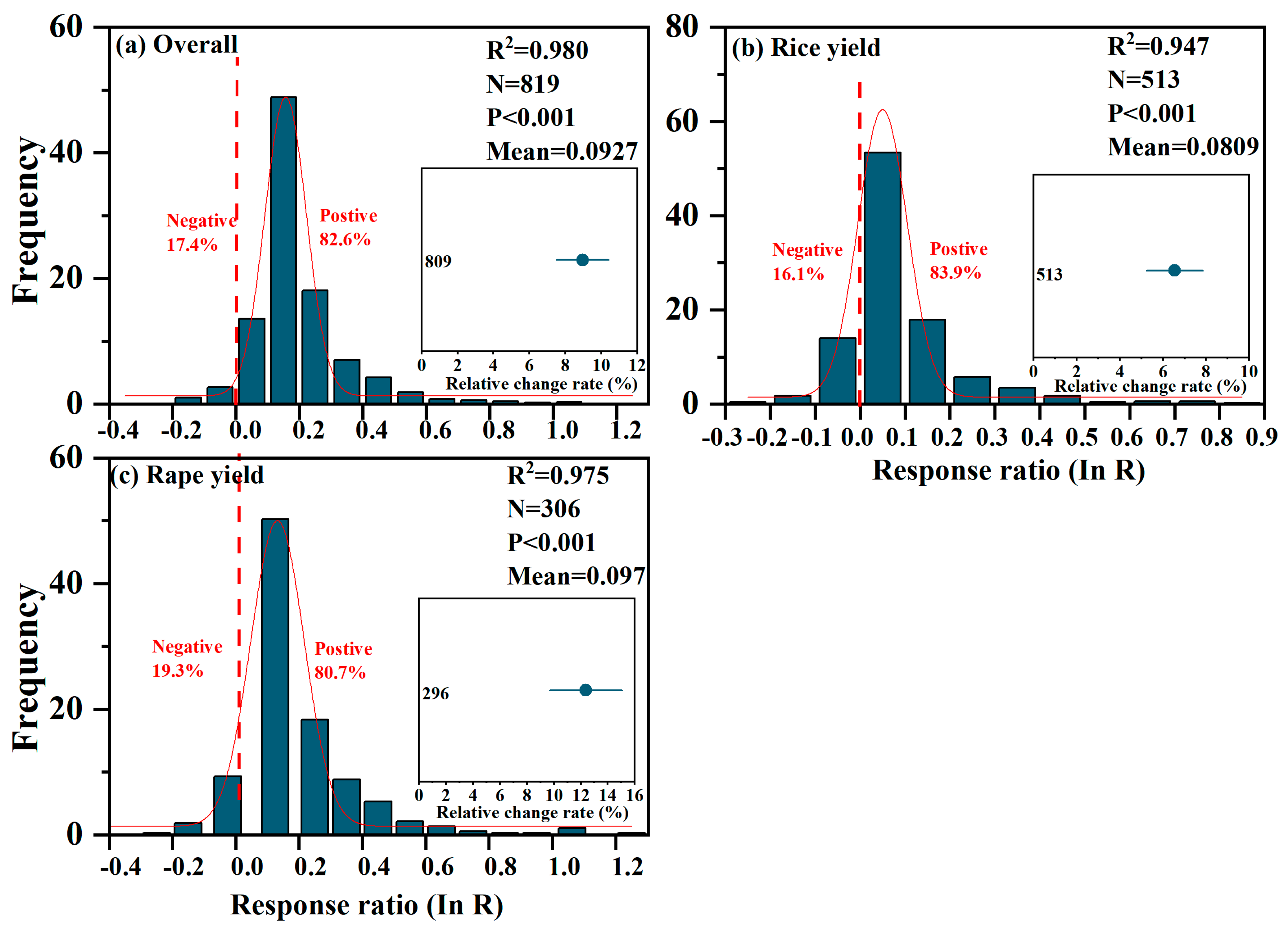
Figure 3.
Distribution of relative changes in soil nutrients and soil physical properties in oilseed–rice cropping systems responding to straw return. (a) Overall; (b) straw return under rice season; (c) straw return under oilseed rape season; SOC, soil organic carbon; AN, soil available nitrogen; AP, soil available phosphorus; AK, soil available potassium; TN, soil total nitrogen; TP, soil total phosphorus; TK, soil total potassium; MBC, microbial biomass carbon; MBN, microbial biomass nitrogen. The numbers on the left of the pictures represent the sample size. The mean effect and 95% confidence interval (CI) are shown if the CI does not overlap with the 0 line, which means significant effects (p < 0.05).
Figure 3.
Distribution of relative changes in soil nutrients and soil physical properties in oilseed–rice cropping systems responding to straw return. (a) Overall; (b) straw return under rice season; (c) straw return under oilseed rape season; SOC, soil organic carbon; AN, soil available nitrogen; AP, soil available phosphorus; AK, soil available potassium; TN, soil total nitrogen; TP, soil total phosphorus; TK, soil total potassium; MBC, microbial biomass carbon; MBN, microbial biomass nitrogen. The numbers on the left of the pictures represent the sample size. The mean effect and 95% confidence interval (CI) are shown if the CI does not overlap with the 0 line, which means significant effects (p < 0.05).
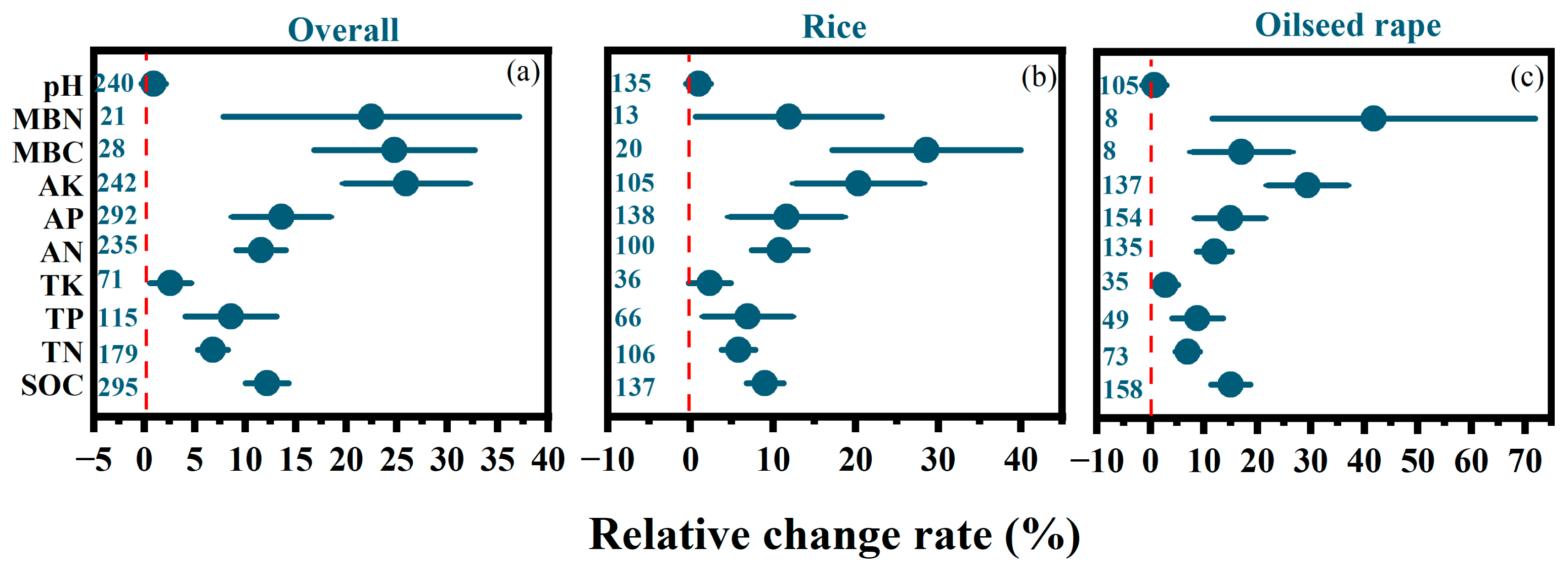
Figure 4.
Relationships between rice yield responses to straw return for soil organic carbon (SOC), pH, soil total nitrogen (TN), soil total phosphorus (TP), soil total potassium (TK), soil available nitrogen (AN), soil available phosphorus (AP), and soil available potassium (AK) in the oilseed rape–rice cropping system. The red line in the figure is the line of the fitted equation for the two covariates, y is the rice yield responses to straw return, x is the dimension of the region where the sample is located, and the red area is the 95% confidence interval of the fitted equation.
Figure 4.
Relationships between rice yield responses to straw return for soil organic carbon (SOC), pH, soil total nitrogen (TN), soil total phosphorus (TP), soil total potassium (TK), soil available nitrogen (AN), soil available phosphorus (AP), and soil available potassium (AK) in the oilseed rape–rice cropping system. The red line in the figure is the line of the fitted equation for the two covariates, y is the rice yield responses to straw return, x is the dimension of the region where the sample is located, and the red area is the 95% confidence interval of the fitted equation.
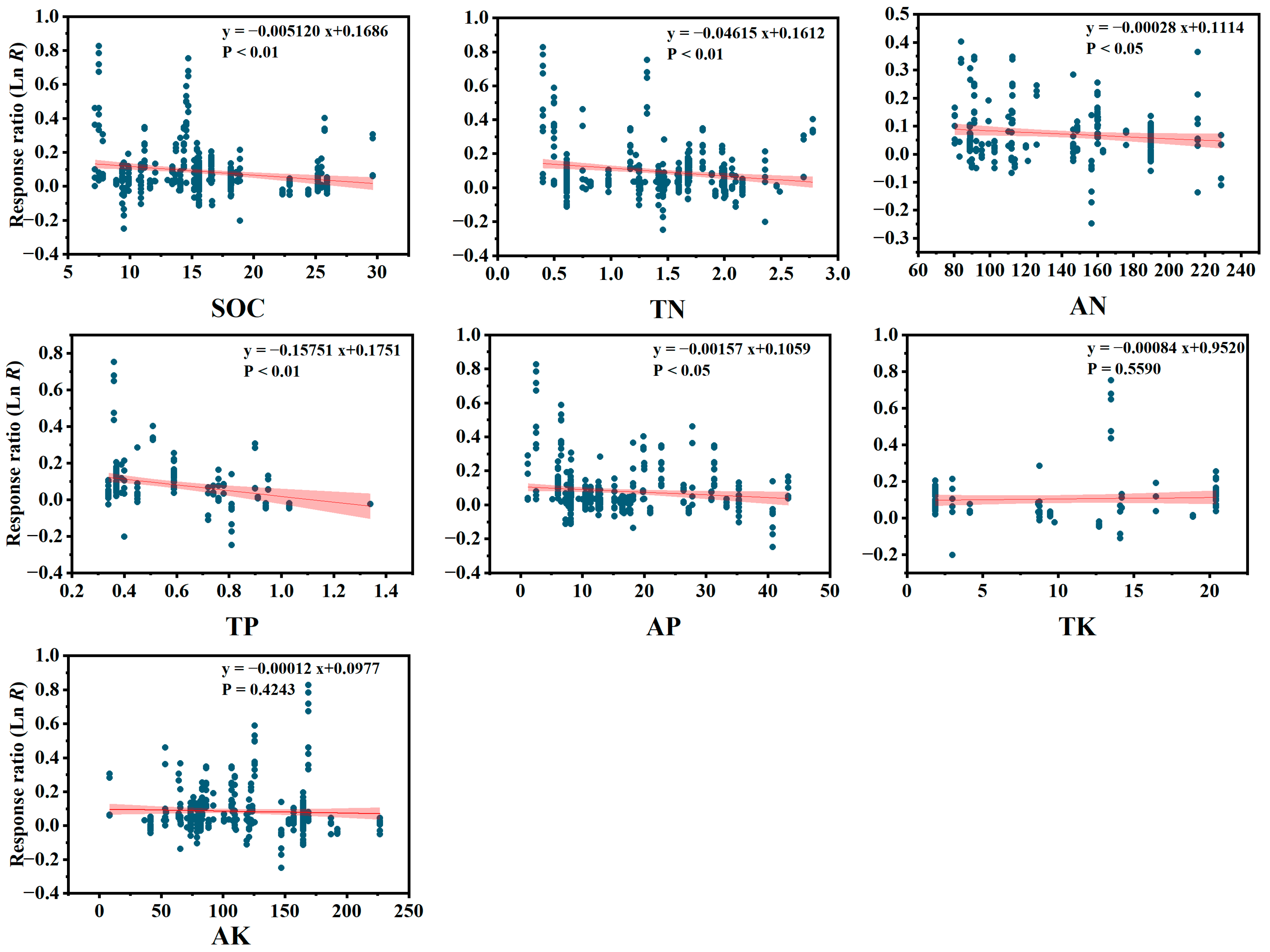
Figure 5.
Relationships between oilseed rape yield responses to straw return for soil organic carbon (SOC), pH, soil total nitrogen (TN), soil total phosphorus (TP), soil total potassium (TK), soil available nitrogen (AN), soil available phosphorus (AP), and soil available potassium (AK) in the oilseed rape–rice cropping system. The red line in the figure is the line of the fitted equation for the two covariates, y is the oilseed rape yield responses to straw return, x is the dimension of the region where the sample is located, and the red area is the 95% confidence interval of the fitted equation.
Figure 5.
Relationships between oilseed rape yield responses to straw return for soil organic carbon (SOC), pH, soil total nitrogen (TN), soil total phosphorus (TP), soil total potassium (TK), soil available nitrogen (AN), soil available phosphorus (AP), and soil available potassium (AK) in the oilseed rape–rice cropping system. The red line in the figure is the line of the fitted equation for the two covariates, y is the oilseed rape yield responses to straw return, x is the dimension of the region where the sample is located, and the red area is the 95% confidence interval of the fitted equation.
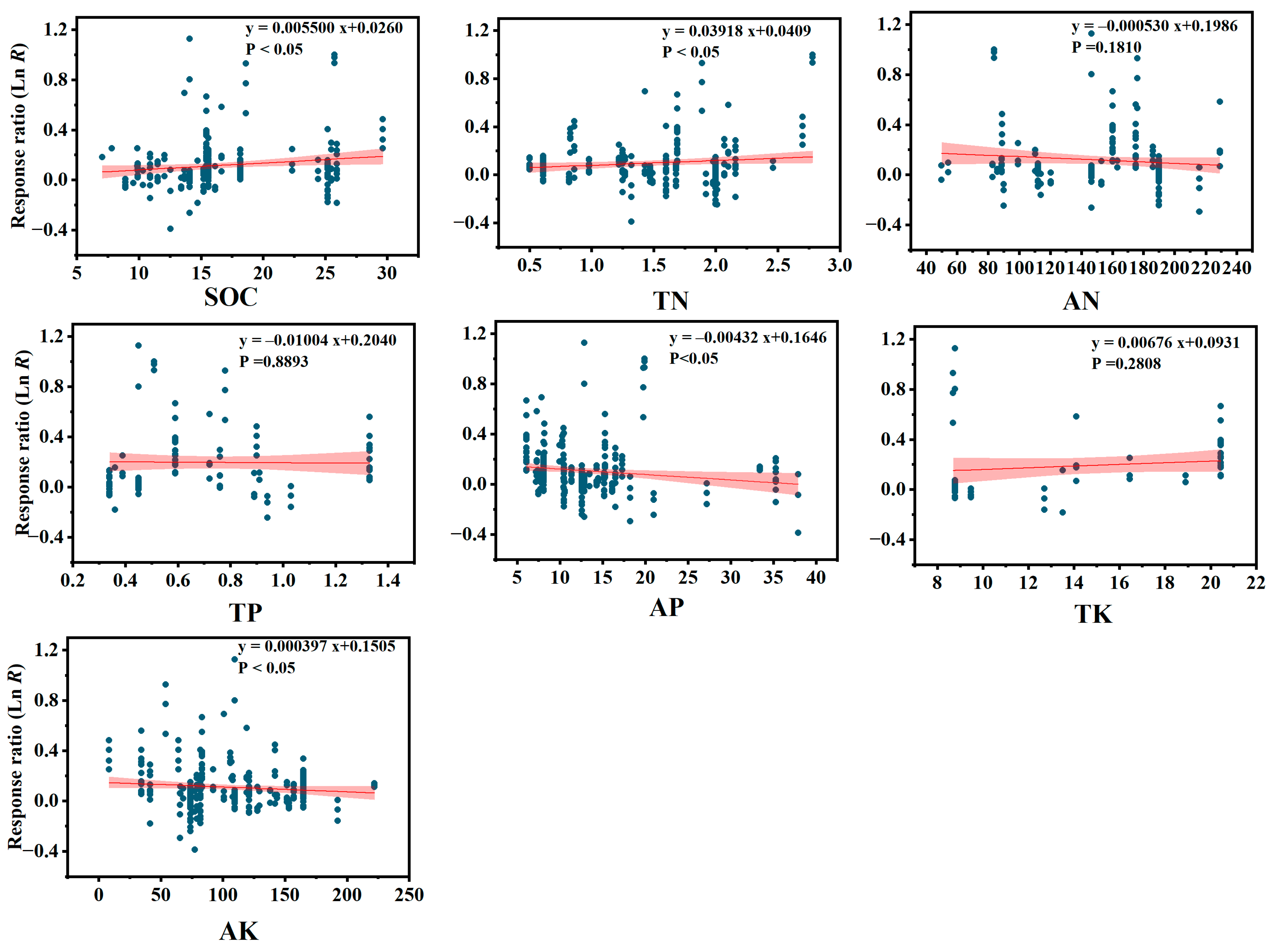
Figure 6.
The effect of straw return on crop yield and soil properties under different climatic conditions during the rice–oilseed cropping systems by mean annual temperature and mean annual precipitation. Note: SOC, soil organic carbon, AN, soil available nitrogen, AP, soil available phosphorus, AK, soil available potassium, TN, soil total nitrogen, TP, soil total phosphorus, TK, soil total potassium. The numbers on the left of the pictures represent the sample size. The mean effect and 95% confidence interval (CI) are shown if the CI does not overlap with the 0 line, which means significant effects (p < 0.05).
Figure 6.
The effect of straw return on crop yield and soil properties under different climatic conditions during the rice–oilseed cropping systems by mean annual temperature and mean annual precipitation. Note: SOC, soil organic carbon, AN, soil available nitrogen, AP, soil available phosphorus, AK, soil available potassium, TN, soil total nitrogen, TP, soil total phosphorus, TK, soil total potassium. The numbers on the left of the pictures represent the sample size. The mean effect and 95% confidence interval (CI) are shown if the CI does not overlap with the 0 line, which means significant effects (p < 0.05).
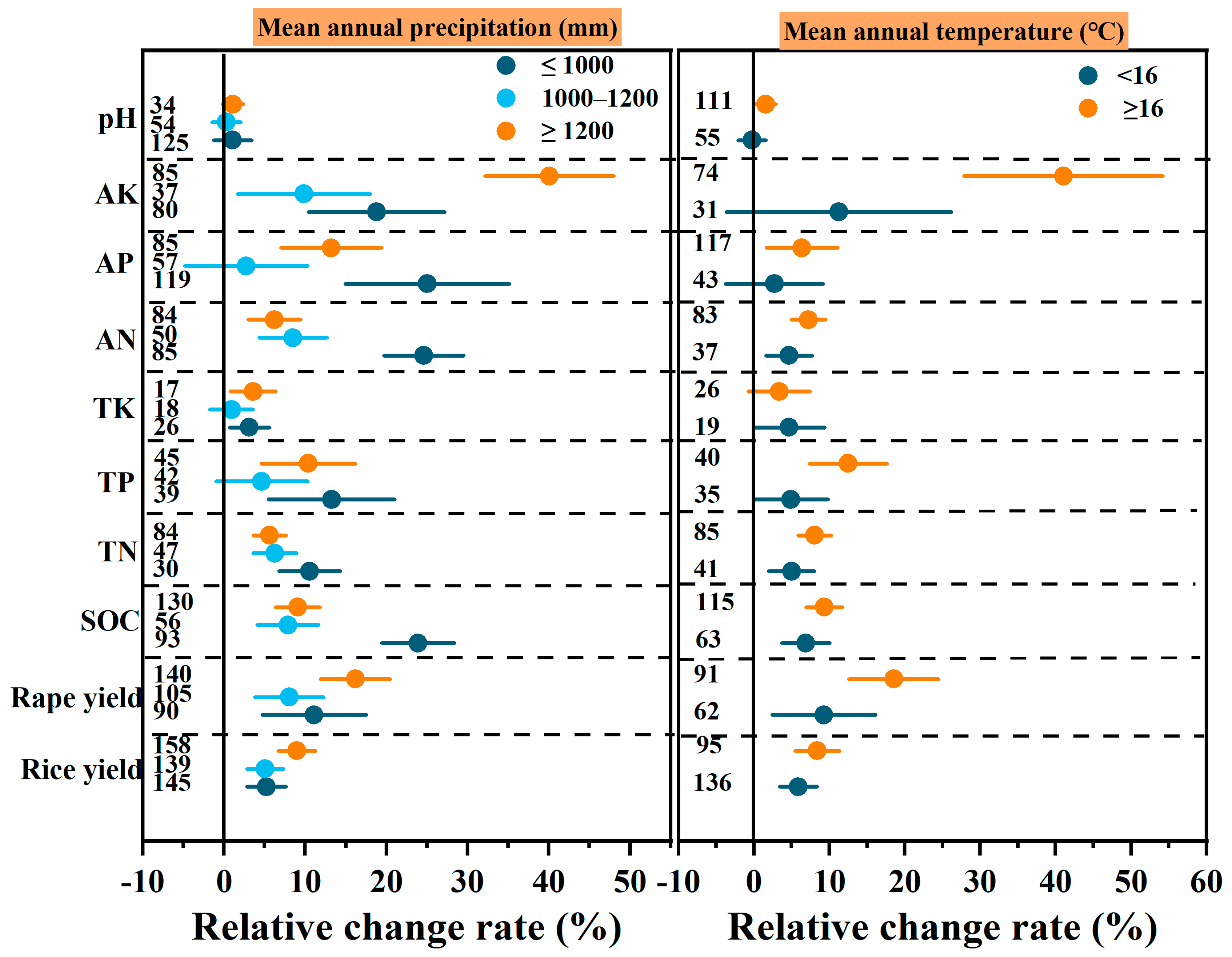
Figure 7.
Relationships between rice yield (A,B) and oilseed rape yield (C,D) responses to straw return for mean annual temperature and mean annual precipitation in the oilseed rape–rice cropping system. The red line in the figure is the line of the fitted equation for the two covariates, y is the rice yield (A,B) and rape yield (C,D) responses to straw return, x is the dimension of the region where the sample is located, and the red area is the 95% confidence interval of the fitted equation.
Figure 7.
Relationships between rice yield (A,B) and oilseed rape yield (C,D) responses to straw return for mean annual temperature and mean annual precipitation in the oilseed rape–rice cropping system. The red line in the figure is the line of the fitted equation for the two covariates, y is the rice yield (A,B) and rape yield (C,D) responses to straw return, x is the dimension of the region where the sample is located, and the red area is the 95% confidence interval of the fitted equation.
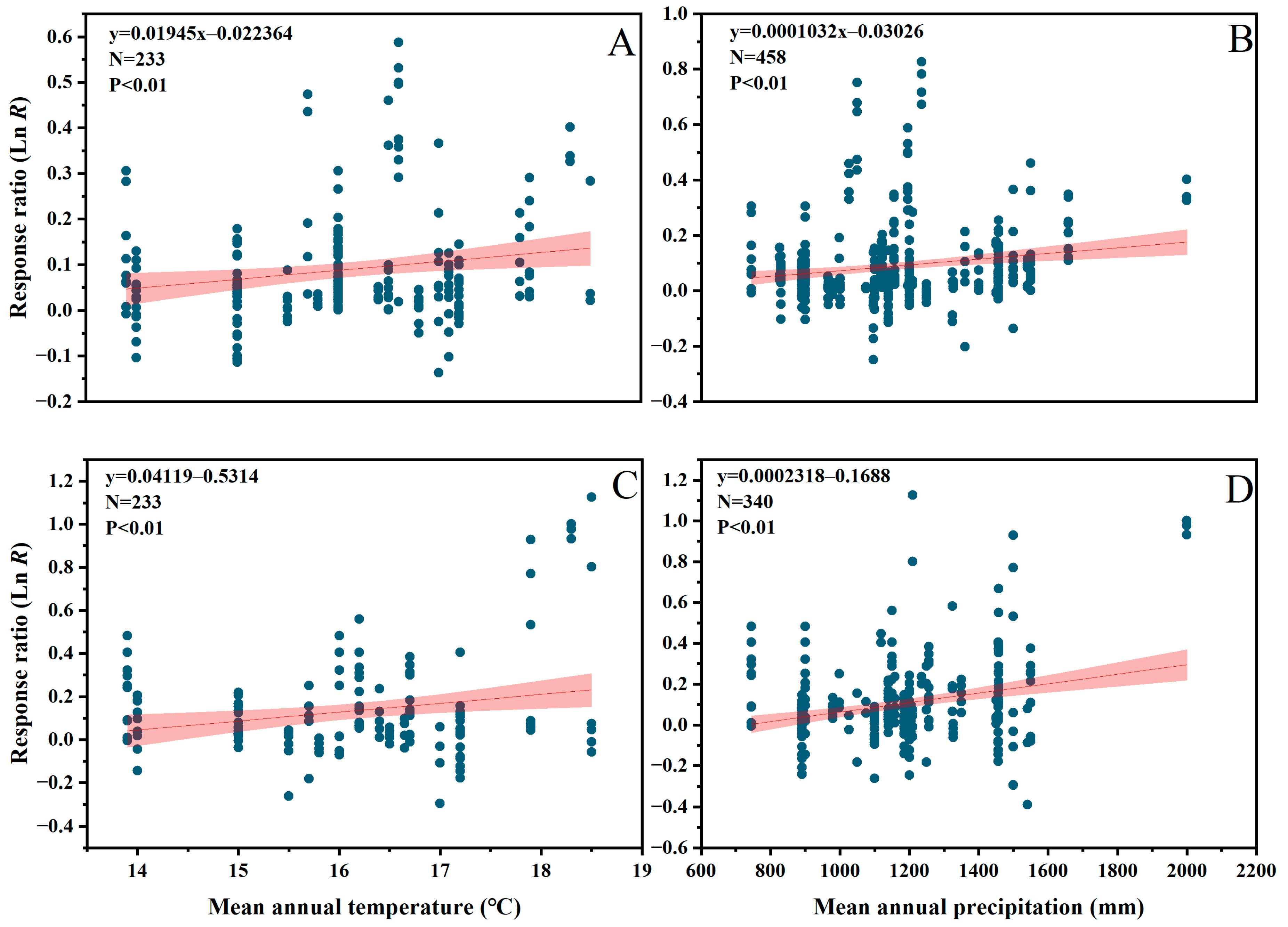
Figure 8.
Effects of different soil conditions, i.e., soil organic carbon (SOC), soil pH, and soil texture of straw return on crop yield and soil nutrients in a rice–oilseed rape cropping system. Note: AN, soil available nitrogen, AP, soil available phosphorus, AK, soil available potassium, TN, soil total nitrogen, TP, soil total phosphorus, TK, soil total potassium. The numbers on the left of the pictures represent the sample size. The mean effect and 95% confidence interval (CI) are shown if the CI does not overlap with the 0 line, which means significant effects (p < 0.05).
Figure 8.
Effects of different soil conditions, i.e., soil organic carbon (SOC), soil pH, and soil texture of straw return on crop yield and soil nutrients in a rice–oilseed rape cropping system. Note: AN, soil available nitrogen, AP, soil available phosphorus, AK, soil available potassium, TN, soil total nitrogen, TP, soil total phosphorus, TK, soil total potassium. The numbers on the left of the pictures represent the sample size. The mean effect and 95% confidence interval (CI) are shown if the CI does not overlap with the 0 line, which means significant effects (p < 0.05).
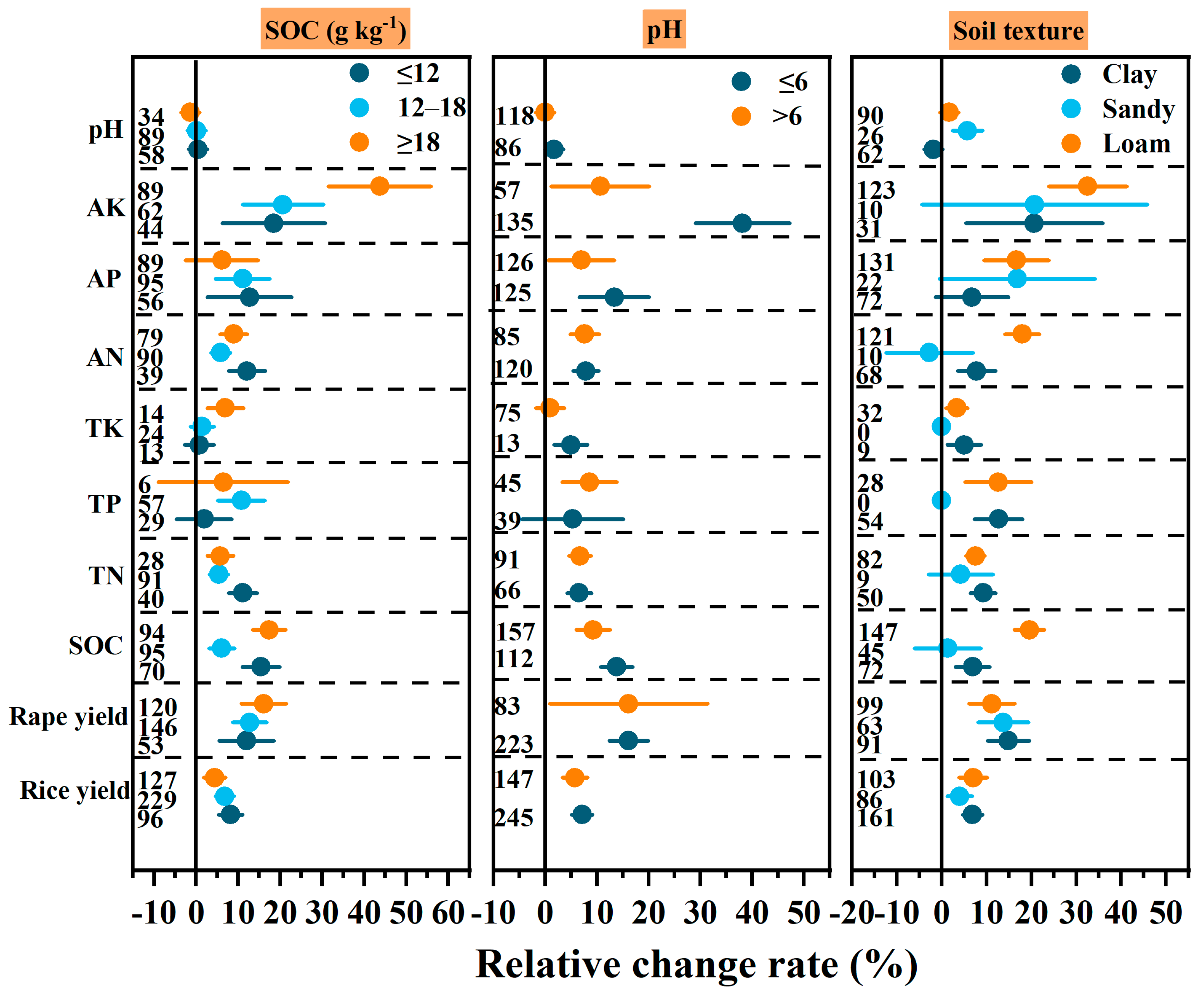
Figure 9.
Effects of different agricultural practices i.e., fertilizer, N application rate, tillage, straw return method on crop yield and soil nutrients in a rice–oilseed rape cropping system. Note: SOC, soil organic carbon, AN, soil available nitrogen, AP, soil available phosphorus, AK, soil available potassium, TN, soil total nitrogen, TP, soil total phosphorus, TK, soil total potassium. The numbers on the left of the pictures represent the sample size. The mean effect and 95% confidence interval (CI) are shown if the CI does not overlap with the 0 line, which means significant effects (p < 0.05).
Figure 9.
Effects of different agricultural practices i.e., fertilizer, N application rate, tillage, straw return method on crop yield and soil nutrients in a rice–oilseed rape cropping system. Note: SOC, soil organic carbon, AN, soil available nitrogen, AP, soil available phosphorus, AK, soil available potassium, TN, soil total nitrogen, TP, soil total phosphorus, TK, soil total potassium. The numbers on the left of the pictures represent the sample size. The mean effect and 95% confidence interval (CI) are shown if the CI does not overlap with the 0 line, which means significant effects (p < 0.05).
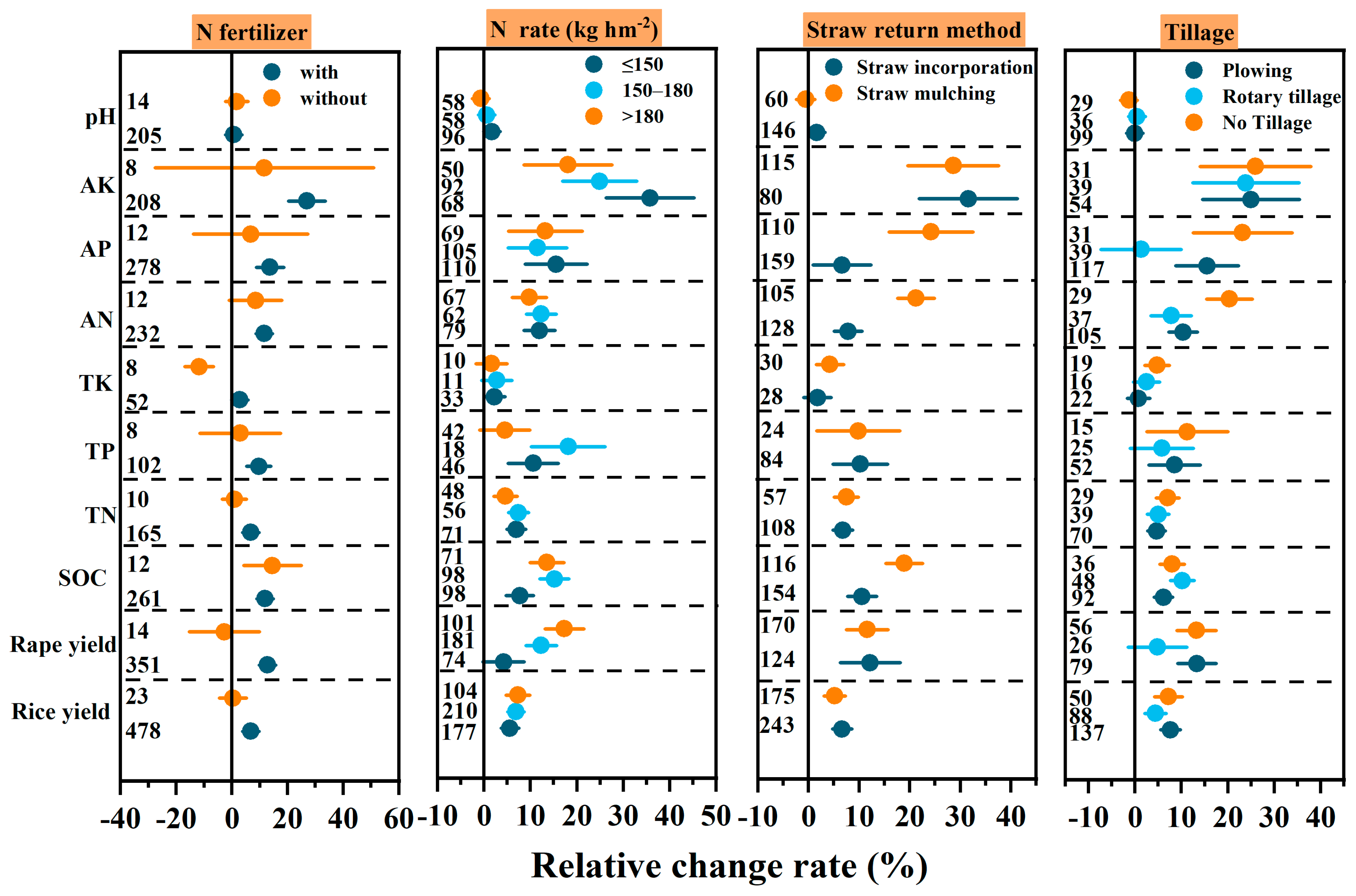
Figure 10.
Relationships between rice yield responses to straw return for soil organic carbon (SOC), pH, soil total nitrogen (TN), soil total phosphorus (TP), soil total potassium (TK), soil available nitrogen (AN), soil available phosphorus (AP), soil available potassium (AK), and pH in the oilseed rape–rice cropping system. The red line in the figure is the line of the fitted equation for the two covariates, y is the rice yield responses to straw return, x is the dimension of the soil nutrients responses to straw return, and the dark green area is the 95% confidence interval of the fitted equation.
Figure 10.
Relationships between rice yield responses to straw return for soil organic carbon (SOC), pH, soil total nitrogen (TN), soil total phosphorus (TP), soil total potassium (TK), soil available nitrogen (AN), soil available phosphorus (AP), soil available potassium (AK), and pH in the oilseed rape–rice cropping system. The red line in the figure is the line of the fitted equation for the two covariates, y is the rice yield responses to straw return, x is the dimension of the soil nutrients responses to straw return, and the dark green area is the 95% confidence interval of the fitted equation.
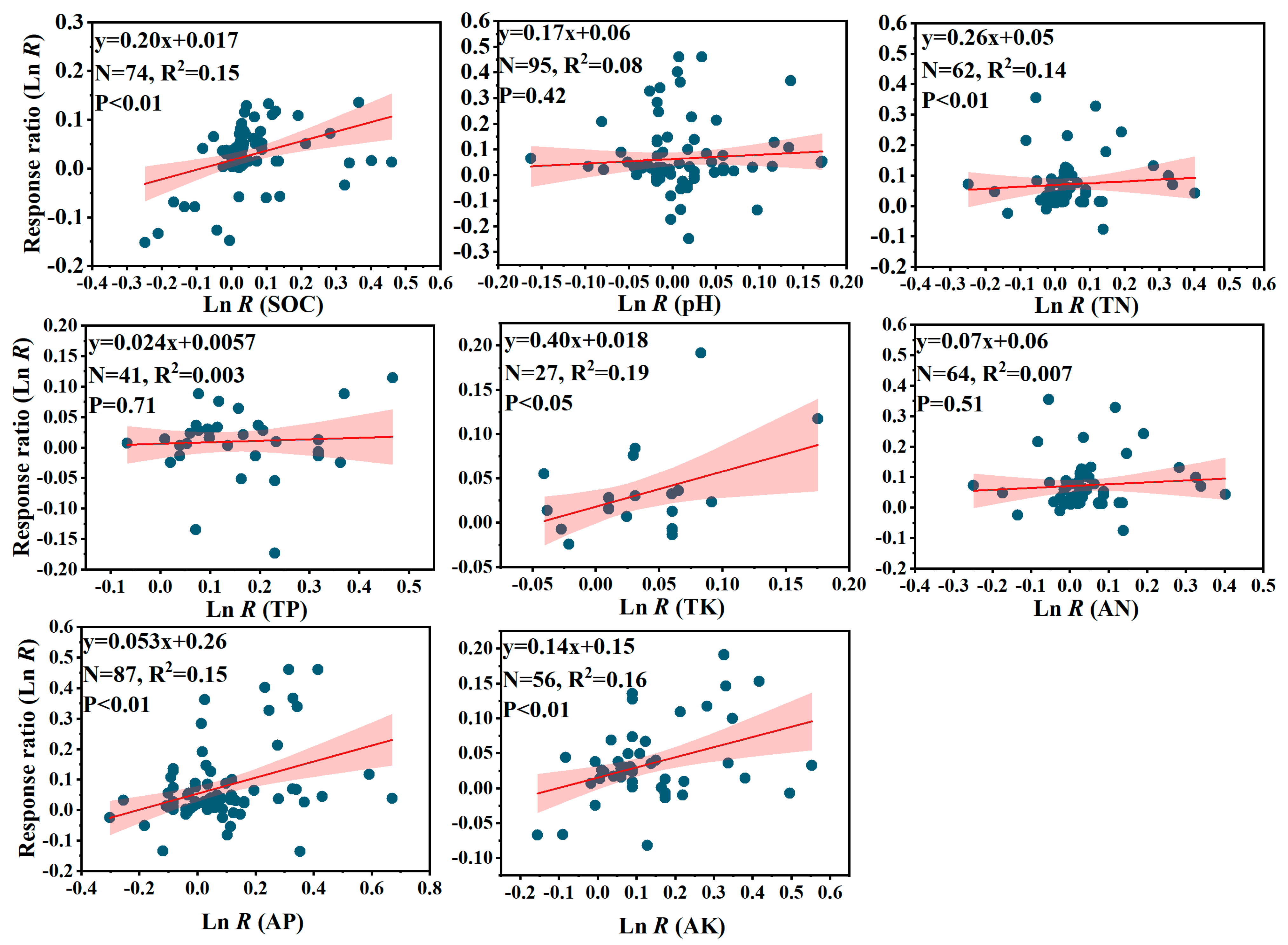
Figure 11.
Relationships between rape yield responses to straw return for soil organic carbon (SOC), pH, soil total nitrogen (TN), soil total phosphorus (TP), soil total potassium (TK), soil available nitrogen (AN), soil available phosphorus (AP), soil available potassium (AK), and pH in the oilseed rape–rice cropping system. The red line in the figure is the line of the fitted equation for the two covariates, y is the rape yield responses to straw return, x is the dimension of the soil nutrient responses to straw return, and the dark green area is the 95% confidence interval of the fitted equation.
Figure 11.
Relationships between rape yield responses to straw return for soil organic carbon (SOC), pH, soil total nitrogen (TN), soil total phosphorus (TP), soil total potassium (TK), soil available nitrogen (AN), soil available phosphorus (AP), soil available potassium (AK), and pH in the oilseed rape–rice cropping system. The red line in the figure is the line of the fitted equation for the two covariates, y is the rape yield responses to straw return, x is the dimension of the soil nutrient responses to straw return, and the dark green area is the 95% confidence interval of the fitted equation.
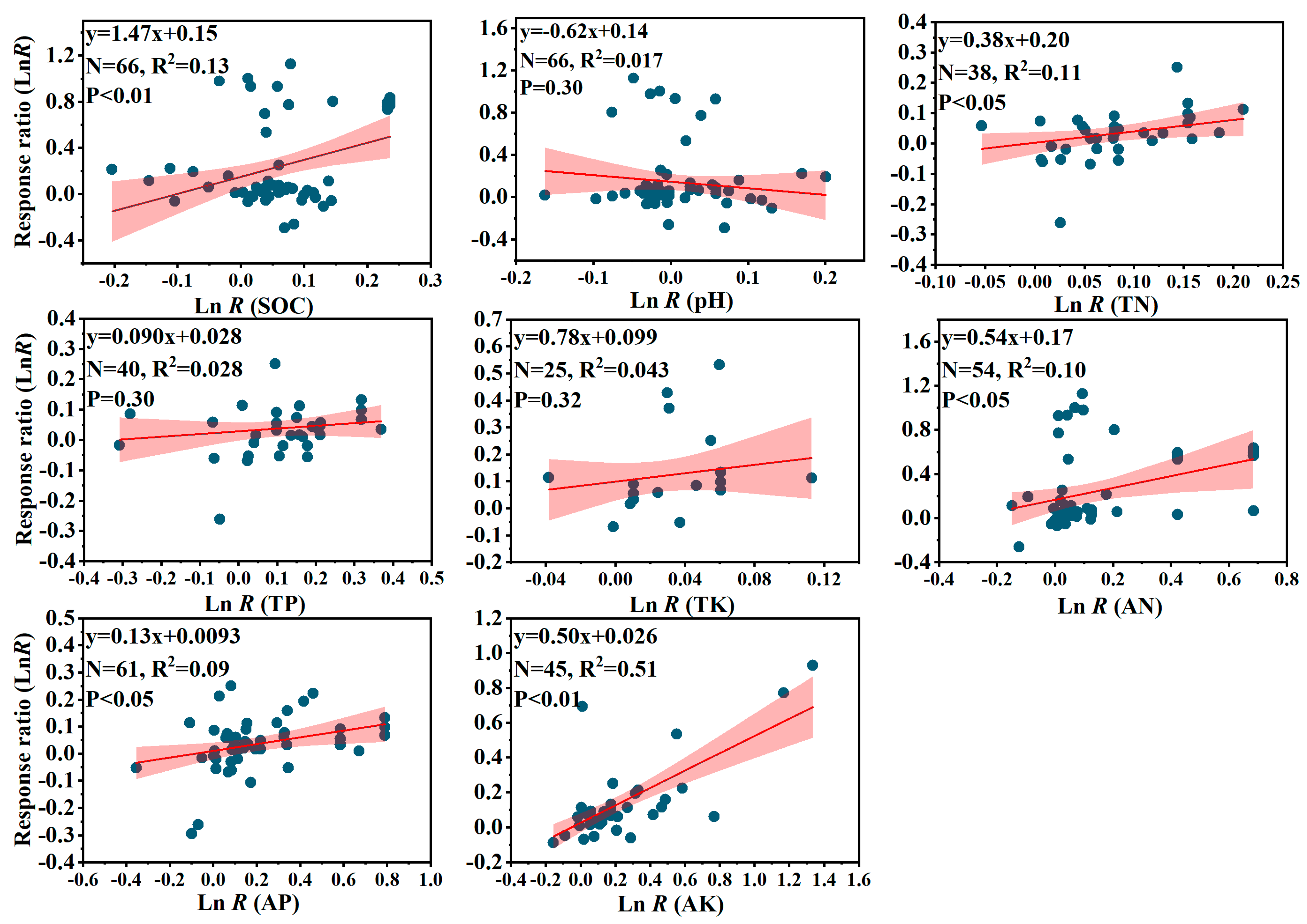
Figure 12.
The relative importance (%) of variables for rice yield (a) and rape yield (b) response to straw return based on random forest regression model. Note: Continuous variables included mean annual precipitation (MAP), mean annual temperature (MAT), N rate, initial soil conditions (soil total nitrogen (TN), soil total phosphorus (TP), soil total potassium (TK), soil available nitrogen (AN), soil available phosphorus (AP), soil available potassium (AK), soil organic carbon (SOC), pH; categorical variables included texture, tillage, and method in this meta-analysis.
Figure 12.
The relative importance (%) of variables for rice yield (a) and rape yield (b) response to straw return based on random forest regression model. Note: Continuous variables included mean annual precipitation (MAP), mean annual temperature (MAT), N rate, initial soil conditions (soil total nitrogen (TN), soil total phosphorus (TP), soil total potassium (TK), soil available nitrogen (AN), soil available phosphorus (AP), soil available potassium (AK), soil organic carbon (SOC), pH; categorical variables included texture, tillage, and method in this meta-analysis.
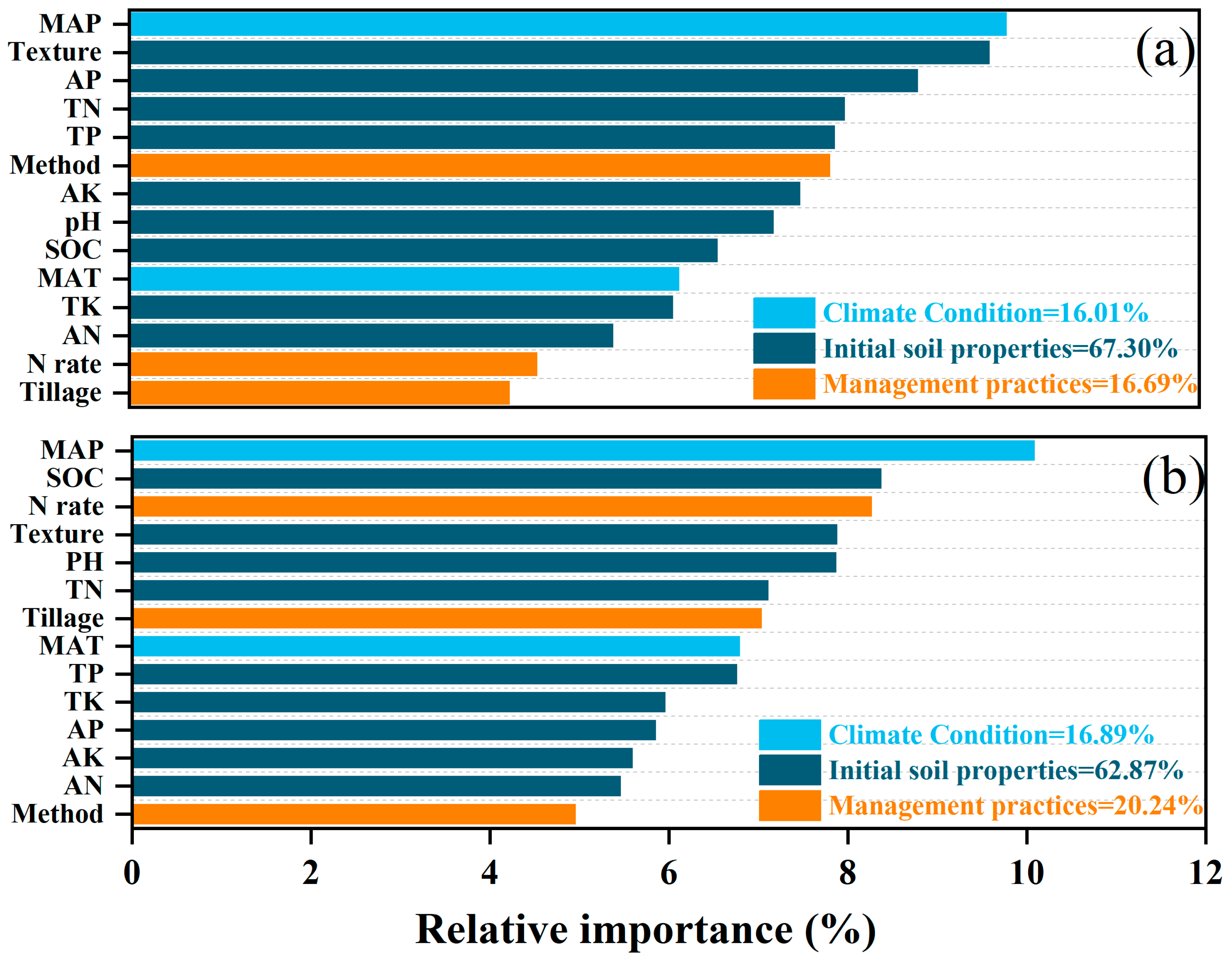
[ad_2]


